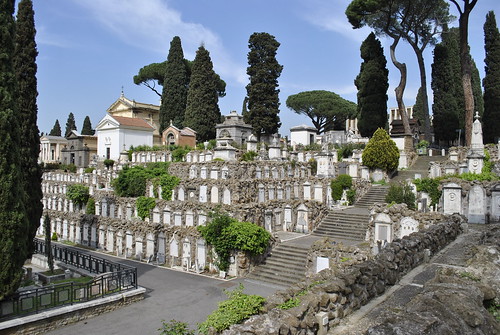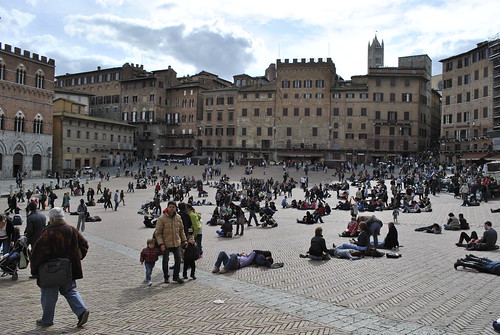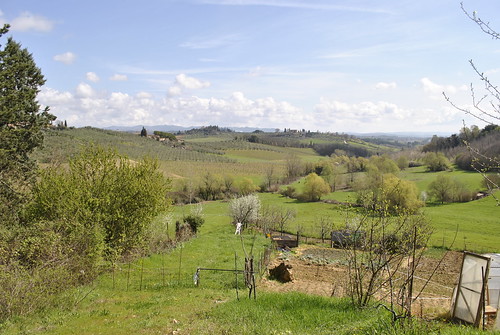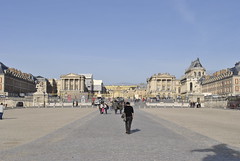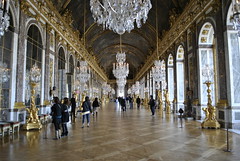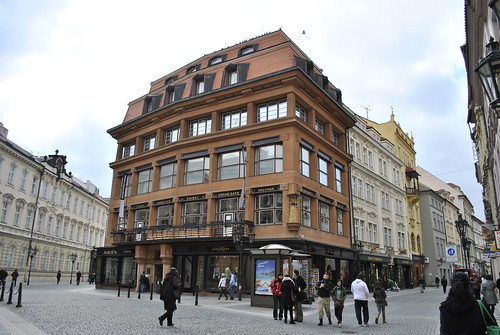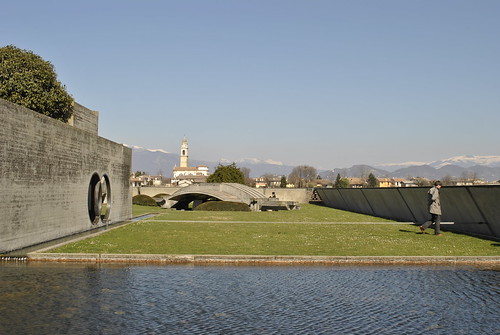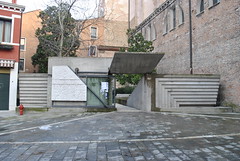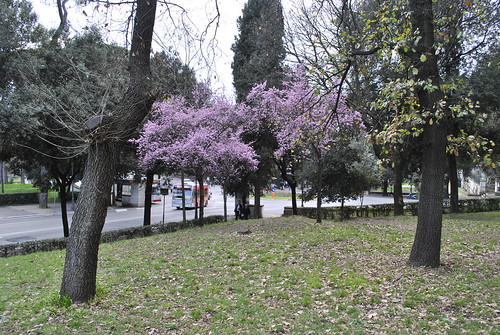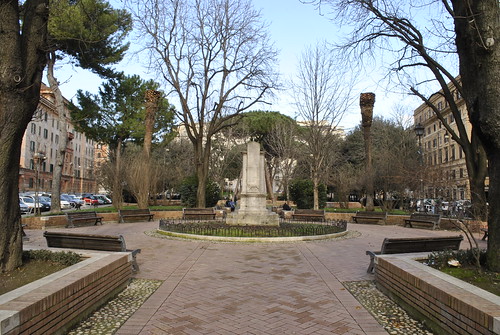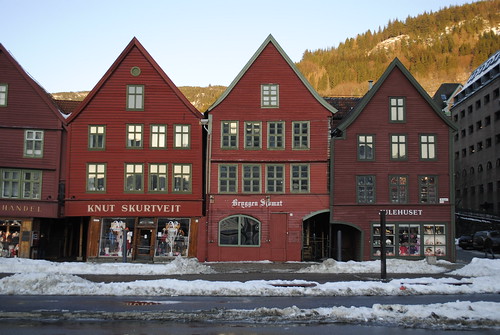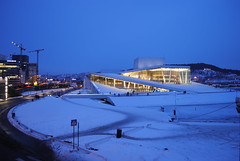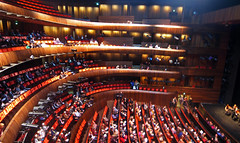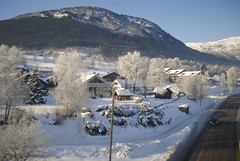On Friday I went to the Cimitero del Verona (Verona Cemetery), when I was close by on a visit to my studio site at Porta Maggiore. It is the primary municipal cemetery in Rome and opened in 1812. It covers an immense area (see map) and is organized in a grid layout. Toward the front of the cemetery the blocks were filled with various smaller monuments and family tombs. Further in, entire blocks are occupied by large mausoleum buildings, two or three stories high. Built at different times, there are a variety of different styles. The newer ones are pretty plane, resembling a typical contemporary building in Rome. Inside are levels of individual tombs accessed by staircases. I was intrigued by how many of these, essentially buildings, have been built solely for burials. It is literally a city for the dead. The cemetery was very peaceful to walk through on a sunny day. I occasionally saw a grounds keeper or another visitor, but otherwise there were not very many people there. See photos here.
Category: Study Abroad (page 2 of 4)
We had a four day weekend in Rome for Easter, so a friend and I decided to take a short trip to Siena Friday through Saturday (April 2-3). Siena is a small city in the Tuscany region, about 250 km north of Rome. It was a very relaxing trip and the weather cooperated nicely. We spent a lot of time sitting in Piazza del Campo, the major square in the old town and famous for the twice-annual horse race held there. The irregular semicircular piazza (photo below) slopes down to one point so people gather there and sit and lay down, unlike most piazzas that are flat and have few places to sit. There were hundreds of people there during the day enjoying the sun, but at night activity is mostly limited to the perimeter restaurants, bars and cafes.
On the piazza is the Palazzo Publico, originally a town hall built in around 1300, with the Torre del Mangia campanile. We went up the tower for great views of Siena and the Tuscan countryside in all directions. The Palazzo is now a museum, which we went through too. Most interesting was a temporary exhibit on Bauhaus architecture which included several drawings by Walter Gropius and other Bauhaus and modernist architects, plus a number of architectural models of their works.
We stayed at a campground located outside the old city, which rented small trailer cabins. It was actually quite new and nice – and inexpensive. It was a pretty nice campground with its own restaurant and bar. Two bus routes ran between the city and the campground, but on Saturday we decided to walk back into the city instead. We happened upon Basilica dell’Osservanza, a modest brick church and monastery standing alone in the countryside. Originally built around 1490, it was rebuilt after being almost entirely destroyed in World War II. The exterior brickwork was attractive on its own, with the cupola (roof tip of bell tower) entirely in brick as well. Inside was small and minimal, and still regularly in use. It was refreshing to see. A few other churches we saw in Siena also had more modest interiors.
Architecturally almost all of Siena’s old buildings have brick facades, instead of stucco like in Rome. This was much more attractive, without crumbling, dirty stucco covering the real walls. In more contemporary areas surrounding the old city, the buildings are pretty similar to those in Rome and other cities in Italy. Overall Siena is a very attractive, pleasant city. The surrounding Tuscany landscape was the most beautiful scenery I have seen so far in Italy (though the weather and time of season probably had something to do with it). I really enjoyed walking through the countryside and getting to explore the small, charming city as well. It was a great short break from school and Rome. See all photos here.
The second half of spring break my friend and I were in Paris. We flew from Prague very early in the morning on Thursday (March 18), and arrived into the city a little after 8am at Gare du Nord (North Station), a few blocks east of our hostel, located probably a mile or two north of the river and the center of the city. After finding the hostel we took the Metro “downtown” near most of the major museums, sites and tourist attractions Paris has to offer.
First impression of Paris – it is enormous and a little disorienting if you don’t have a solid sense of direction where you are. Not really what I had been expecting, the different sites seem much more disjointed. Unlike Rome where the central ancient city is a deceivingly small area, Paris is just the opposite with everything further apart than one might expect from a map view. The overall scale of buildings and blocks in Paris are of course much larger than in Rome. Certainly more orderly (considering sventramento, the later slicing through of wide avenues through the city), but more difficult to comprehend at a human scale due to its urban massiveness. There seems to be less hierarchy between major and minor streets, so it is not as easy to orient oneself to a particular prominent thoroughfare. An aspect of Rome I may have criticized before, the juxtaposition of ancient and newer neighborhoods of contrasting scales and configurations, is actually quite useful for someone unfamiliar to be able to tell distinctly when moving between different portions of the city.
On our first day in Paris we went to a few of the major sites: Notre Dame, the Pantheon, and of course the Eiffel Tower. The spatial quality around the Eiffel Tower was not what I expected. It seemed much less grand on the ground than I had imagined. We walked up to the second level (not the very top) which still provided a great view of the city in all directions.
Friday morning we met up with my friend and classmate Jackson who was also visiting Paris that week and actually staying in the same hostel. We took a regional train out to visit the Palace of Versailes. The gardens were massive but unfortunately not in bloom yet as we visited in mid March. I enjoyed the Hall of Mirrors. After a few hours Spencer and I returned into the city for lunch and a visit to the Louvre. The museum was enormous, but we actually didn’t stay there very long. We then took a long Metro ride out to see Parc de La Villette that I wanted to check out. It is a large contemporary park (1980s) designed by Bernard Tschumi, with 35 “follies” – large red cubes placed on a grid throughout the park that are all deconstructed into various forms and functions. Like most places, it was not quite as I had imagined, but it was certainly interesting to experience.
On our last day Saturday we visited the Pompidou Centre. I enjoyed the contemporary exhibits much more than those in the Louvre. For lunch we ate at a cafe nearby. On our way to the bus stop to the airport, we stopped at La Défense. We flew out of Paris Beauvais, a very small rural airport, and got back to Rome around midnight.
I’m glad I made it to Paris. Given our short time there and the massive size of Paris, we mostly had to stick to sightseeing and didn’t really get to explore much of the city as a whole. Knowing very little French and being generally fatigued after a week and a half of traveling were also factors. Overall it was a good week though and we were able to see a lot of interesting and significant places. See all my Paris photos here.
Spring break was three weeks ago now, following a week-long class trip to the Veneto region of Italy. My friend Spencer came to visit and we traveled to Prague and Paris during the week with a couple days in Rome at both ends.
We flew from Rome to Prague Monday afternoon (March 15) and were there through early Thursday morning. Despite colder temps and cloudy skies, first impressions of Prague were good. The Prague Airport is nice and new and transportation into the city was easy and inexpensive. A 26 CZK (about $1.50) transit ticket got us a city bus ride and Metro trip to the city center where we were staying. Prague is a transit-intensive city with several metro lines, bus routes and surface tram lines. Like everywhere else I’ve visited in Europe, the bus and tram systems use the honor system where passengers must validate a transit ticket when they board, but oddly the subway metro system also uses this form of payment, instead of a typical access-controlled system with turnstiles or automatic gates. It was quite unusual to be able to just walk freely into the metro. Similar to Rome, a standard ticket permits 75 minutes of unlimited travel.
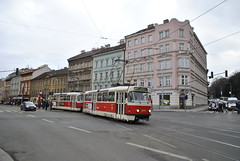 On Tuesday we walked around the city center hitting most of the significant places and sites. The city is large but the old center is quite compact with everything being pretty walkable. Except near the train terminal, everywhere we went was well-maintained and clean. Streets were mostly asphalt or cobblestone with sidewalks paved in decorative cube stones. The urban layout is much more consistent and contingent than in Rome where medieval streets mesh with modern wide thoroughfares and areas are disjointed by ancient ruins. Prague’s architecture is definitely distinct from Rome and more quintessential European. The majority of building facades are painted and pastel tones, making for a very colorful city.
On Tuesday we walked around the city center hitting most of the significant places and sites. The city is large but the old center is quite compact with everything being pretty walkable. Except near the train terminal, everywhere we went was well-maintained and clean. Streets were mostly asphalt or cobblestone with sidewalks paved in decorative cube stones. The urban layout is much more consistent and contingent than in Rome where medieval streets mesh with modern wide thoroughfares and areas are disjointed by ancient ruins. Prague’s architecture is definitely distinct from Rome and more quintessential European. The majority of building facades are painted and pastel tones, making for a very colorful city.
Worth mentioning – the Czech Cubism Museum, housed in the House of the Black Madonna (top photo), the first and most prominent example of cubist architecture in Prague, built in 1912. The exhibit included cubist paintings, sculpture, furniture, and architectural drawings. Very interesting to learn more about an architectural and art movement so specific to Czech, and Prague in particular.
Another major site was the Prague Castle, an enormous, eclectic compound looking over the city of Prague. Dating back to the 9th century AD, several additions of the centuries has made it one of the largest castles in the world, including the Gothic cathedral, St. Vitus. We walked up to the castle, which permits fantastic views of the city, and walk through the outside, not actually going in. We did stop in the cathedral, which was my first Gothic cathedral to experience in person. The space was incredible. The interior height is emphasized by the structural expression of the Gothic style.
For dinner we had some typical Czech fare – dumplings, pork, sauerkraut, and the pub’s beer sampler. We ended up sitting at the end of a table shared with two other men. Evidently most dinning out in Prague is done by reservation.
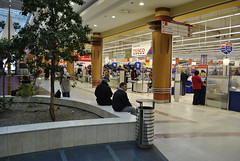 Wednesday, among exploring the city center more on foot, we took the metro to the Žižkov Television Tower, to take in the 360 view from the observation level. Additionally we stopped back at the Nový Smíchov shopping center just a few blocks south of our hotel in the middle of a busy, redeveloped neighborhood called Anděl. The three level shopping center was comparable to American malls on the inside, but the exterior was tastefully hidden behind a long street facade of existing four-five story buildings, with a contemporary glass entrance opening up at one end to a street space surrounded by several other modern glass buildings and a busy tram stop. Nový Smíchov included a movie ciniplex and a full-sized Tesco store, a UK-based big box retailer similar to Walmart.
Wednesday, among exploring the city center more on foot, we took the metro to the Žižkov Television Tower, to take in the 360 view from the observation level. Additionally we stopped back at the Nový Smíchov shopping center just a few blocks south of our hotel in the middle of a busy, redeveloped neighborhood called Anděl. The three level shopping center was comparable to American malls on the inside, but the exterior was tastefully hidden behind a long street facade of existing four-five story buildings, with a contemporary glass entrance opening up at one end to a street space surrounded by several other modern glass buildings and a busy tram stop. Nový Smíchov included a movie ciniplex and a full-sized Tesco store, a UK-based big box retailer similar to Walmart.
That evening we ate at a pretty good Thai restaurant and returned to the hotel pretty early because our early flight to Paris in the morning. We had to get around 3:30 to catch a night bus back to the Prague airport. It was very convenient, going right by our hotel. Prague was a very nice city to visit, modest and well-maintained. Architecturally it is a historic city that does not resist contemporary interventions.
See all my photos from Prague here.
Three weeks ago (March 8-13) we took a class trip to the Veneto region (province) in northern Italy. The studio was split into two groups, the other going south to Sicily. Ours was a bit smaller with only 21 students, so it was pretty relaxing and generally laid back. The weather was colder than the previous week including some snow, but our first day on Monday (March 8 ) was actually quite nice, clear and sunny.
We arrived at Venice Marco Polo Airport midmorning and met our bus. We stopped at an Autogrill for a quick breakfast and proceeded to our first stop at Carlo Scarpa‘s Brion Cemetery. Scarpa designed an L-shape addition that surrounds the existing rural cemetery for Giuseppe Brion and his wife. A nice old Italian man was there to show us in. The predominant material used was concrete, along with metal, wood, and mosaic highlights in a specific place. The cemetery was a beautiful and intriguing place. In a rural location sitting below hills of the Alps, the setting was serene on a gorgeous day.
At lunch time we stopped in a town called Bassano del Grappa, that sits at the foot of the Alps. We walked from a main road into the old city center that had more than one town square before reaching the Ponte Degli Alpini, a covered wooden bridge design by Andrea Palladio in 1569. Bassano del Grappa was the first town we stopped at in Veneto, and the northern influences from Austria and Germany were evident in the architecture, culture and restaurants. My friend and I ate at a German restaurant.
Later that day we stopped at Villa Emo, by architect Andrea Palladio, built in 1559. Interestingly this villa was for agricultural purposes, so in place of elaborate gardens were instead farm fields. The villa itself is very long and slim. The back is left unfinished (just basic brick and stone) facing the fields. The interior and front loggia were decorated in frescoes. I enjoyed walking behind the villa and seeing the agriculture fields beyond, still in use.
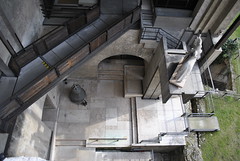 For the first two nights we stayed at a nice hotel in the city center of Verona, a good sized city. Tuesday morning we visited Museo di Castelvecchio, a castle built in the 1350s by the Della Scala family for defense against invasion and outside rebellion. It had various uses over the centuries as Verona had a number of different occupations – under Napoleon radical changes took place including the construction of army barracks. In 1925 it became a museum. In 1958, a new organization of the entire building was planned and undertaken by Carlo Scarpa. His interventions helped unify the different additions and improve navigation through the complex. The attention to detail, tectonics and material connections that Scarpa is known for clearly stood out. We spent about two hours here exploring the museum and sketching.
For the first two nights we stayed at a nice hotel in the city center of Verona, a good sized city. Tuesday morning we visited Museo di Castelvecchio, a castle built in the 1350s by the Della Scala family for defense against invasion and outside rebellion. It had various uses over the centuries as Verona had a number of different occupations – under Napoleon radical changes took place including the construction of army barracks. In 1925 it became a museum. In 1958, a new organization of the entire building was planned and undertaken by Carlo Scarpa. His interventions helped unify the different additions and improve navigation through the complex. The attention to detail, tectonics and material connections that Scarpa is known for clearly stood out. We spent about two hours here exploring the museum and sketching.
We had a little under two hours to explore the city of Verona and grab lunch before regrouping to go to Mantua. This day was much colder than Monday. In Mantua we visited Palazzo Te, a Manarist palace from the 1530s with fantastic frescos. Following we walked into the city stopping at Alberti’s Basilica di Sant’Andrea, currently under heavy renovation. Then we continued to Palazzo Ducale, an enormous complex that is now a museum. While there the snow fall began to really pick up so we returned to Verona for the night.
Wednesday was characterized by snow. We left Verona in the morning heading toward the city of Vicenza. It was a nice longer bus ride through the Berici Hills en route to our first stop at Villa da Schio. This was a much more “hands on” tour, given by a descendent of the Trento family, for which the palazzo is still in hands. Significant about it is the natural air conditioning installed using the cool air from deep quaries in the hills nearby. The caves recently have been used for growing mushrooms and making wine. We had wine tasting there with our packed lunch.
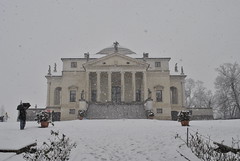 We continued to Villa Rotunda, a 16th century Renaissance summer residence designed by Palladio. Used as a party villa, the building has a centralized plan with four identical porticos. Situated 45 degrees off the north-south axis on a plateau above the surrounding land, direct light is able to reach each facade at some point during the day. While we were there the snow continued to fall and accumulate, which was actually quite a unique experience to see it with snow. Inside there were some corner side rooms, but otherwise we were only in the central rotunda space that occupied most of the building. Once outside we walked around all sides and a light-hearted snow ball fight inevitably broke out. Who else can say they’ve done that at Villa Rotunda? : ) With cold wet feet we went to Vicenza and checked into the hotel, where most people, including myself, took a nap before dinner.
We continued to Villa Rotunda, a 16th century Renaissance summer residence designed by Palladio. Used as a party villa, the building has a centralized plan with four identical porticos. Situated 45 degrees off the north-south axis on a plateau above the surrounding land, direct light is able to reach each facade at some point during the day. While we were there the snow continued to fall and accumulate, which was actually quite a unique experience to see it with snow. Inside there were some corner side rooms, but otherwise we were only in the central rotunda space that occupied most of the building. Once outside we walked around all sides and a light-hearted snow ball fight inevitably broke out. Who else can say they’ve done that at Villa Rotunda? : ) With cold wet feet we went to Vicenza and checked into the hotel, where most people, including myself, took a nap before dinner.
Thursday morning we walked in to the old city to see a number of buildings by Palladio. Of note the Basilica Palladiana, a market building constructed in the 15th century as the seat of government (called Palazzo delle Ragione) and reconstructed in the 16th century by Palladio. He added a new outer shell with a classical loggia of marble, obscuring the original Gothic architecture. Adding a new outer layer presented spatial challenges at the corners, requiring the end arches to actually be smaller. Also the new shell came extremely close to other adjacent buildings.
Also in Vecenza we visited the Teatro Olimpico, the oldest surviving enclosed theater in the world. Designed by Palladio in the 1580s to fit inside an existing old, irregularly shaped fortress. Completed by Vincentzo Scamozzi after Palladio’s death, it was based on his sketches. Included were seven permanent false perspective stage scenes (see photo) that still remain today. We stayed to sketch the theater while a tour group came through for an impressive audio-visual lighting show highlighting the various artifacts and features of the theatre.
We then took a bus to the city of Padua where we visited their Palazzo della Ragione, a civic basilica built in 1218. Claimed to have the largest roof unsupported by columns in Europe, the upper level was a massive open space now used for exhibits. Ground level is still occupied by several small market buildings and now other restaurants and businesses as well. The remainder of the day was free to explore the city. I stopped in a few different churches that were much different than the churches I’ve seen in Rome. The northern European and Venetian influence was quite noticeable.
 Friday morning we took a brief train ride to Venice. We spent a few hours at the Punta della Dogana museum, which is housed in the former customs house, renovations designed by Tadao Ando. The building is triangular ending at its narrowest end with a belvedere tour at the end of the pier. Inside was divided in linear rows which you wind through and around to explore the gallery. With a second level throughout much of the building, there is no prescribed linear pathway through the exhibits. Instead visitors choose their own way through. The second level was open to below in many areas so visually the entire museum was quite connected, but actually getting between levels and different exhibit areas was not as simple. At the narrowest section before the tower is the museum store with a modest cafe. The exhibits on display were pretty interesting, some particularly graphic but indeed intriguing. We had a brief discussion as a group afterwords not only about the building but the exhibits as well. See my sketch to the right.
Friday morning we took a brief train ride to Venice. We spent a few hours at the Punta della Dogana museum, which is housed in the former customs house, renovations designed by Tadao Ando. The building is triangular ending at its narrowest end with a belvedere tour at the end of the pier. Inside was divided in linear rows which you wind through and around to explore the gallery. With a second level throughout much of the building, there is no prescribed linear pathway through the exhibits. Instead visitors choose their own way through. The second level was open to below in many areas so visually the entire museum was quite connected, but actually getting between levels and different exhibit areas was not as simple. At the narrowest section before the tower is the museum store with a modest cafe. The exhibits on display were pretty interesting, some particularly graphic but indeed intriguing. We had a brief discussion as a group afterwords not only about the building but the exhibits as well. See my sketch to the right.
At lunch time I made my way over to Piazza San Marco (St. Mark’s Square – left photo below), the dominant square in Venice where St Mark’s Basilica and its associated campanile are located. About a thousand years old now, the basilica is one of the most famous examples of Byzantine architecture. I was looking forward to seeing it, being one of the select churches I specifically remembered from arch history, now four years ago. The scale of the church and certainly the piazza was much larger than I had imagined. Construction work was being done at the base of the campenile and parts of the building facades bounding the piazza were covered in scaffolding. The basilica was beautiful, but its current situation was pretty tacky with crowd barriers everywhere and a makeshift souvenier shop set up at the entrance.
After regrouping briefly with the whole class we went to see a modest bridge designed by Carlo Scarpa. Then a small group of us took an obligatory, but nonetheless enjoyable gondola ride around the canals. Besides general exploring, a friend and I also checked out the Faculty of Architecture campus of the Universitá luav di Venezia, not far from our hotel with a Scarpa designed entrance (above right photo). We ended up walking around inside and in the library where students were working. It was interesting to see the facilities and to an extent, the work style of architecture education in Italy.
To end the trip, that evening we had a group dinner at a seafood restaurant. It was much less elaborate than the larger group dinner in Perugia, but still good. On the walk back we stopped for gelato, but it was not the best. In the morning we left early to fly back and returned to Rome by noon. It was an intense trip and we got to see a lot of different sites and visited a number of cities.
See my trip photos here.
Yesterday I went to the Museum of Rome in Trastevere, one of several museums in the Museum System of the Municipality of Rome. Located in a former monastery hidden in the dense streets of Trastevere, this museum’s permanent collection focuses on daily life in Rome in the 18th and 19th century. A lot of scenes in paintings were right around the neighborhood so we recognized many.
Currently on exhibit were the works of contemporary American painter Lawrence Ferlinghetti, and photographer Stephen Shore. Shore’s exhibit Biographical Landscape was a collection of photos of ordinary and familiar scenes of the American landscape in the 70s, that one normally doesn’t stop to notice. It was a neat exhibit and very interesting to see, especially in Rome. I wondered what the Italians think of these scenes that are so typical in America.
The museum was relatively small and easy to get through in a little over an hour. Each exhibit only had a few signs with background information and let the art speak for itself. (Image from brochure)

It was a pretty good weekend in and around Rome. Friday night 18 of us took part in a special one-time cooking class with a guy Rob, who teaches some semesters for the COD Rome Program, and his companion Sabrina. A food connoisseur and self-described prostitute [not really] and pseudo intellectual, Rob showed us how to make a full course Italian dinner and talked about the importance of food in Italian culture. It was held at Palazzo Cenci, the floor above our studio space in an apartment of one of our professors. With an extremely small kitchen it was a pretty impressive undertaking. I think usually they try to be more hands on but there simply was not enough room. On the bright site we got a fantastic full course dinner for 35 euro and got to see it all being prepared.
The dinner started out with antipasta with an onion omelet, followed by a small salad topped with a small slice of a complex loaf-like combination of potato and goat cheese (don’t recall the actual name). The pasta was spinach ricotta ravioli made from scratch, followed by fried potatoes and chicken with a pear sauce. For a dessert was a creamy pudding dish with cocoa powder and a lemon liquor. All in all it took a little over five hours. Interesting to see, and some great food.
Saturday two others and I went to Tivoli, a small city not far from Rome. To get there we took the Metro line B from Termini and caught a suburban bus line from a further out station. In Tivoli we visited Villa d’Este, a 16th century Renaissance villa built on the steep terrain. It was a gorgeous day to walk around the gardens and see some countryside. After the villa we walked around the city center a little bit before catching the bus back to Rome. (Photos here.)
Sunday I went with two other friends to Ostia Antica, an enormous archeological site of the harbor city for ancient Rome. Originally at the mouth of the Tiber River, it is now a few kilometers from the sea due because of sediment build up over the centuries and change in sea level. It was fun to walk through the well preserved remains and see various mosaics and frescoes. The weather was not quite as nice this day and was quite windy. Overall a pretty active weekend.
Today (Wednesday) was a beautiful day outside (in the 60s) and I had the afternoon free so I spent sometime exploring Villa Borghese, a large public park in Rome, formerly a private villa for the Borghese family. It is the second largest public park in the city, following Villa Doria Pamphili, which I wandered upon this past Sunday. I had a great time just walking around and enjoying the weather. It was a nice retreat from the dense and busy city and made me think of a lot of other retreat parks in urban areas in the US, as well as large city parks that include many different civic and cultural attractions such as zoos and museums.
While Villa Borghese was originally a private suburban party villa for Scipione Borghese, it is now public and includes the Bioparco (zoo), National Gallery of Modern Art, and other smaller villas from the 1911 world exposition here. Relatable examples in the US would be Forest Park in St. Louis, City Park in Denver, and of course the great lakefront parks in Chicago. Closer to home I was reminded of Bever Park and Ellis Park in Cedar Rapids that were originally suburban parks to provide a public retreat from the city. Bever Park also includes a zoo that at one time had a pretty impressive collection of animals.
I spent about two hours strolling around Villa Borghese and then walked back along Via Vittorio Veneto, a street I went down on the bus ride there. It is a very attractive, well-kept (and expensive) area that feels more Parisian than Roman. Wide clean sidewalks, separated from the street by grass medians and flowerbeds, accommodate several permanent pavilions for restaurant dining areas.
It was a very nice afternoon. I look forward to spending more time outside in Rome as the weather continues to get nicer as we head into spring. See photos from today here.
It was a delightful sunny Saturday afternoon in Rome, following a bit of a dreary, but relatively warm morning. After lunch my friend Jenna and I decided to enjoy the nice weather with gelato in a park. We went to one of my favorite parks I’ve seen so far, Piazza di Santa Maria Liberatrice in the Testaccio neighborhood just across the river to the south of Trastevere. The neighborhood is relatively small, sandwiched between the Tiber to the west, the Aventine Hill to the east and Monte Testaccio (Rome’s ancient Mount Trashmore) and old industry to the south. The area was sparsely populated with poor rural settlements before the mid to late 19th century when it was developed for worker housing for the industries nearby. It is one of the few cases of planned urbanization in Rome.
Laid out in a grid system, the neighborhood has a sense of continuation within and with the rest of the city, despite actually being somewhat tucked away. The regular streets disguise the neighborhood’s small size, giving a sense it could continue endlessly. It is characterized mostly by 6-8 story apartment buildings with sidewalk level shops, a market building, one large early 20th century church Santa Maria Liberatrice, and of course its associated piazza.
Piazza di Santa Maria Liberatrice is really more of a park compared to a typical Rome piazza. It is two blocks long and triangular shaped with a large playground at the wide end and a large open plaza in the center that flows into a brick pathway lined with benches leading to the narrow end near the church. The entire piazza is filled with trees and areas of green. The few actual grassy areas are separated by small grade changes with brick retaining walls and benches, discouraging walking there, so they have actually been maintained pretty well compared to most places with grass in the city. The abundance of trees and breaking up the piazza with different elements create several smaller spaces instead of one single open space which is more typical of Roman piazzas. This makes the piazza much more versatile and useful for more and different people. The scale and aesthetic of the buildings surrounding the piazza provide a well defined edge around the urban space.
After we got our gelato from a place at the corner, we took a bench in a nook between the playground and the larger central plaza. The playground was very active today with several children and their parents out enjoying the nice weather. Across from us three old men were sitting and shooting the breeze over a smoke. Soon several of the local pigeons congregated around us as we were finishing our cones. I laid a few crumbs down near me to see how close they would come. One little guy in particular was trying to get closer but kept beating around the bush. A small lonely sparrow came out from his hiding spot under a bush so I threw him (or her) a piece.
Later on a few boys started of a game of soccer in the central plaza space – the biggest kid as the goalie. Meanwhile the old men went on their way and a new crew took their place. The mini world cup was a fierce match but all in good fun. When the ball went astray there was plenty of help getting it back. A middle aged man sitting on the bench next to us tossed it back first. Then a young father passing through with his daughter in an all-terrain stroller kicked it back to them. The next foul ball went high into the air right towards the new group of old guys. I can only imagine the brief terror those kids experienced as the ball went hurling through the air towards them. But the men shrugged it off and all was well. It was a captivating game that got everyone involved.
The interaction of different people, different generations, and different creatures makes visiting this park a wonderful experience. It is a park that encourage and facilities an endless number of activities through its design and amenities like the playground and ample sittable space. The different spaces within it are at a human scale, making them inviting and comfortable to be in. The buildings and church that frame the park give it context and a sense of place, making it special and unique to that community. Piazza di Santa Maria Liberatrice is everything a great urban neighborhood park should be – and a great place to enjoy the day with some gelato.
For a long week end two weeks ago (Feb 6-8), three others and I had a delightful time visiting Norway. Overall impressions from our brief visit were extremely positive, despite being very cold compared to Rome. After returning from Perugia Friday night, we headed back out of Rome early Saturday morning on a 6:30 flight to Oslo.
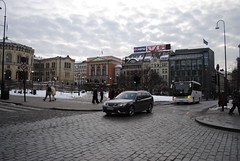 Once we got into the city we checked into our hostel, just blocks from the bus and train stations in the city center. In search of lunch we walked down Karl Johans Gate, the “main street” of downtown Oslo running between the rail station on the east and the Royal Palace at the west end. A number of the blocks on the easter end have been turned into a pedestrian mall with a very trendy retail scene. Further west the street opens back up to traffic near the Stortinget (Parliament of Norway), the beginning of a park that runs the rest of the way to the Royal Palace grounds. The park includes a plaza in front o the Storinget, a large fountain turned skating rink in the winter, and the National Theatre building. This seems to be the real heart of Oslo. Several buildings on the south edge of the park, some modern, but most more traditional had electronic advertisements and signs atop, like it was Norway’s version of Times Square.
Once we got into the city we checked into our hostel, just blocks from the bus and train stations in the city center. In search of lunch we walked down Karl Johans Gate, the “main street” of downtown Oslo running between the rail station on the east and the Royal Palace at the west end. A number of the blocks on the easter end have been turned into a pedestrian mall with a very trendy retail scene. Further west the street opens back up to traffic near the Stortinget (Parliament of Norway), the beginning of a park that runs the rest of the way to the Royal Palace grounds. The park includes a plaza in front o the Storinget, a large fountain turned skating rink in the winter, and the National Theatre building. This seems to be the real heart of Oslo. Several buildings on the south edge of the park, some modern, but most more traditional had electronic advertisements and signs atop, like it was Norway’s version of Times Square.
Just a block or so south of the park is Oslo Rådhus (City Hall), a monumental brick building facing the Oslo Fjord. Next to this area is Aker Brygge, an old shipyard that was redeveloped into offices and shopping starting in the 1980s. This small area had an incredible collection of new architecture with creative facades and use of different materials. It was almost overwhelming to take it all in with so many intriguing buildings. One area where a street opens up, two small sittable spaces are created by the pavement mounding up to create an artificial brick berm. A small child was playing on one. I can only imagine how popular these are when it is warmer.
We then headed over to the Oslo Opera House as the sun was beginning to set (around 3:30pm), with a quick stop at the National Museum of Art, Architecture and Design that we spotted on the way. The Opera House was simply amazing. We walked up the sloped roof and had a delightful time trekking all around on top. The accessible roof connects the physically-isolated opera house with the rest of downtown by providing fantastic views of the city. The architecture is engaging and interactive for everyone, not just those going to a performance. It becomes much more than a cultural asset, but has social and urban virtues as well.
When we explored the lobby we decided to get tickets for that evening’s National Opera orchestra concert. Cheap seats were for 100 Kroner (around $17) so not bad at all. The concert started at 7:30, featuring music from Strauss and Beethoven. The performance was enjoyable and nice to hear some recognizable pieces, not to mention experiencing the event in a world-renowned venue. Inside the performance hall was clad in variations of horizontal and vertical wood lines that I particularly liked. (Anyone who’s been in studio with me knows I have a thing for parallel [wood] lines in architecture, so you can imagine what a grand time I was having in Norway.)
After the show we asked our usher, who seemed to be about our age, where a good place would be to go out nearby since we hadn’t eaten yet. Her friend suggested a place a few blocks north around Youngstorget Square. We found it and discovered it was only a bar and we still needed to eat. Being used to the late dinning custom in Italy (and not exactly familiar with that in Norway) we found ourselves almost out of luck besides perhaps McDonald’s. We stopped back at our hostel, not far to ask the clerk where we could find something to eat. He directed us to the Cathedral Cafe on Karl Johans Gate, serving local Norwegian food we were in search of. I got a Norwegian Ringnes beer and a dish of salmon with hallandale sauce and boiled potatoes (not sure what the dish name was). After eating it was nearing midnight so we all turned in for the evening with another early morning ahead of us.
In the morning we walked to the train station a few blocks away to catch our NSB Bergen Railway train, departing a little after 8:00. This was my first trip by train in Europe so was pretty excited for it. We boarded and found our seats; the train was quite empty to start. The cars were modern and comfortable. Despite being one of the more memorable parts of the trip, it is hard to describe in depth through words. The route weaved in and around snow covered mountain peaks, alongside fiords and small towns. Initially it was interesting to watch as we left Oslo and how the city transitioned into rural. Housing types were actually quite similar to the United States. The train ride was a little over seven hours, running a bit late toward the end. The scenery just kept getting better and better as we approached Bergen.
Once we arrived in Bergen we walked a few blocks to our hostel. This one was not quite as accommodating as the one in Oslo, but it was good enough for the night. Since we only had a short amount of daylight left we were swift to drop off our things and head out exploring. We walked a few blocks to Bryggen (see photo at top), a series of Hanseatic commercial buildings along the fjord. This is the oldest part of the city, dating back to 1070, but due to various fires the oldest buildings only date back to the 1700s.
Soon Jamin and I split from the other two and took the Fløibanen cable railway to the top of the hill. From there was a spectacular view of the entire city, clarifying to us how large Bergen actually was. From the small area near the train station and our hostel, we perceived the city much smaller than it is and didn’t get to many areas with taller, more contemporary buildings. The top was busy today not only with sightseers, but also skiiers with a cross country ski trail running right by. A restaurant and a gift shop were also at the top. We stopped in the gift shop for a while to warm up, waiting for the sun to set a little to get photos of the city below. I bought a Kvikk Lunsj (quick lunch) bar that was extremely similar to a Kit-Kat. But don’t tell them that! (according to Wikipedia)
We went back down and regrouped with the other two around 6:30. We walked around the city center a bit more and around the University of Bergen campus nearby. Then we had similar issues finding dinner as we did in Oslo, despite going much earlier this time. Many restaurants seemed to be closed or not serving food (because it was Sunday perhaps?). We went into an Irish pub that looked good just to find out the kitchen was closed because the chef was sick. Aaron and Chester settled on an Indian restaurant we had walked by, while Jamin and I opted for the less expensive choice across the street at a small gyro / pizza place.
This was the first place we encountered that didn’t speak any English – the guy working appeared to be an immigrant so he only knew some Norwegian. I was looking for a pizza with onions so we were able to ask what was on one particular kind, so he pointed to the ingredients, one that looked kind of like onions. As he was putting it together I noticed a different container over by the gyros that clearly was onion, and realized we had ordered a pepperoni, pineapple and paprika pizza. (Pineapple not my fave) The pizza was good anyway and came with cucumber sauce for dipping. It was also really inexpensive (by Norwegian standards) at only 149 NOK for the large pizza and two drinks. We headed back to the hostel for another early night to bed, followed by another early morning.
The morning (Monday) came very soon. We left the hostel by 5:45 to make it to the bus station to catch the 6:30 Flybuss to the airport. We had an 8:10 flight out of Bergen to Rygge Airport, another airport by Oslo. We took another bus back into the city center of Oslo, but only had about two and a half hours until we had to catch another bus back to Torp Airport to make our return flight again. The bus transport between airports and the city ended up taking longer than expect and due to the scheduling, we had a lot less time back in Oslo than originally expected.
On a mission to get some photos and a souvenir knit hat, I walked down Karl Johans Gate to near the Royal Palace before swinging down to the shop near the Rådhus. On the way Jamin and I stopped at a bakery along the Storinget park for coffee and a cinnamon roll. I went down the building’s lower level where a sporting goods store was to find a restroom. While browsing their hats a store clerk approached me and asked if I needed anything in Norwegian. As I responded in English he realized I wasn’t Norwegian, smiled and apologized with a friendly pat on the back. Not to overgeneralize an entire population, but everyone here was extremely friendly and helpful. This was only one example.
The visit to Norway was very enjoyable. It was great to see the beautiful countryside and experience the quaintness of Bergen and neat urbanism in Oslo. The contemporary architecture of Norway is handsome and sophisticated, but not overly conservative or boring. Oslo has a delightful combination of old and new, existing more or less harmoniously together. It was a very nice change of scenery from Rome where there are very few examples of really attractive contemporary architecture.
See all my Norway photos here.
© 2022 URBAN THINKING
Theme by Anders Noren — Up ↑
